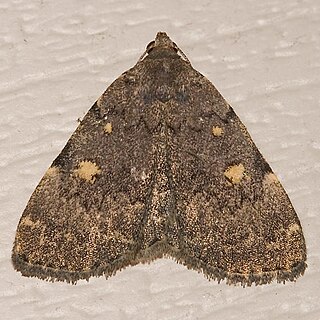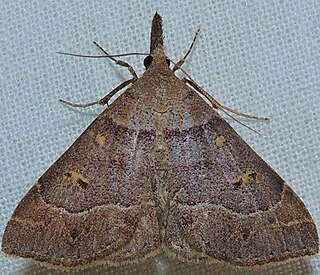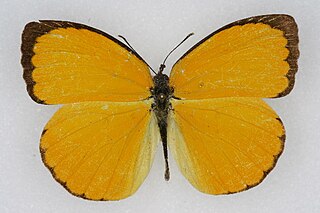
Hyles gallii, the bedstraw hawk-moth or galium sphinx, is a moth of the family Sphingidae. The species was first described by S. A. von Rottemburg in 1775.

Idia is a genus of litter moths of the family Erebidae first described by Jacob Hübner in 1813.

Tetragonus catamitus, the common butterfly moth, or Philippine callidulid moth, is a moth of the family Callidulidae. It was first described by Carl Geyer in 1832. Noted from Taiwan, north-eastern India, south-west India, the Andaman and Nicobar Islands, Sri Lanka, the Tenasserim Hills of Myanmar and from Java. They are day-flying moths that can be easily mistaken for a butterfly due to the position in which they hold their wings.

Diachrysia balluca, the green-patched looper, is a moth of the family Noctuidae. The species was first described by Carl Geyer in 1832. It is found in north-eastern North America from Nova Scotia west to Manitoba and south to western North Carolina. Great Smoky Mountains National Park is the southern limit of this species. The only other records in the south are from the type locality of Georgia and a record from Liberty County in north-western Florida. These possibly represent strays.

Idia aemula, the common idia, powdered snout or waved tabby, is a litter moth of the family Erebidae. The species was first described by Jacob Hübner in 1813. It is found from Canada south to Florida and Texas. It has been reported in the Palearctic.
Idia occidentalis is a species of litter moth of the family Erebidae first described by Smith in 1884. It is found in North America from southern Alberta and British Columbia, south to Colorado, Arizona and California.

Idia americalis, the American idia or American snout, is a litter moth of the family Erebidae. The species was first described by Achille Guenée in 1854. It is commonly found in moist forests in North America, ranging from southern Canada to Florida and Texas. It is nocturnal and can be lured by sugar baits and light traps.

Idia diminuendis, the orange-spotted idia, is a litter moth of the family Erebidae. The species was first described by William Barnes and James Halliday McDunnough in 1918. It is found in North America from Wisconsin to Nova Scotia, south to Florida and Texas.

Idia forbesii, or Forbes' idia moth, is a litter moth of the family Erebidae. The species was first described by George Hazen French in 1894. It is found in North America from Wisconsin to Quebec, south to Florida and Texas.
Idia julia, or Julia's idia, is a litter moth of the family Erebidae. The species was first described by William Barnes and James Halliday McDunnough in 1918. It is found from southern Canada south to Georgia and Texas.

Idia rotundalis, the chocolate idia or rotund idia moth, is a litter moth of the family Erebidae. The species was first described by Francis Walker in 1866. It is found from southern Canada to Florida and Texas.
Idia scobialis, the smoky idia, is a litter moth of the family Erebidae. The species was first described by Augustus Radcliffe Grote in 1880. It is found in North America from Michigan, southern Quebec and Maine, south to Florida and at least Kentucky.
Idia denticulalis, the toothed idia, is a litter moth of the family Erebidae. The species was first described by Leon F. Harvey in 1875. It is found in Quebec, Canada, and the US from Wisconsin to New England, south to Alabama and Texas.
Idia laurentii, the laurentine idia, is a litter moth of the family Erebidae. The species was first described by J. B. Smith in 1893. It is found in the US from central New York, south to the mountains of North Carolina.
Idia majoralis, the greater idia, is a litter moth of the family Erebidae. The species was first described by J. B. Smith in 1895. It is found in Canada from Ontario and Quebec, south into the United States, where it has been recorded from Illinois, Wisconsin and Missouri.
Idia immaculalis, the immaculate idia, is a litter moth of the family Erebidae. The species was first described by George Duryea Hulst in 1886. It is found in North America from at least California, north and east across Montana to southern Alberta and Saskatchewan.

Renia flavipunctalis, the yellow-dotted renia, yellow-spotted renia or even-lined renia, is a litter moth of the family Erebidae. The species was first described by Carl Geyer in 1832. It is found from southern Canada to Florida and Texas.

Eurema dina, the dina yellow, is a butterfly in the family Pieridae. The species was first described by Felipe Poey in 1832. It is found from Panama north to southern Florida. The species is regularly recorded from southern Texas and south-eastern Arizona. The habitat consists of forest edges, brushy fields and open forest.
Conchylodes diphteralis is a moth in the family Crambidae. It was described by Carl Geyer in 1832. It is found from the southeastern United States, where it has been recorded from Florida, through the West Indies to South America.
Black moth or Black Moth can refer to:












